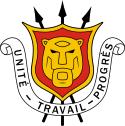Council of Ministers (Burundi)
 |
|---|
|
|
The Council of Ministers of Burundi are the senior level of the executive branch of Burundi and consists of the Prime Minister of Burundi and various Ministers. The 2018 constitution, which enshrines ethnically based power-sharing, requires that at most 60% of ministers come from the ethnic Hutu majority and at most 40% hail from the Tutsi minority. At least 30% of government ministers must be women.[1] The members of the council are directly appointed by the President in consultation with the Vice-President and Prime minister.[2]
The current council of ministers commenced on 28 June 2020 and was President Évariste Ndayishimiye's first cabinet.[3]
Members of the government named in 2020
[edit]President Évariste Ndayishimiye's first council was a total of 15 ministers of which 5 were women.[4]
Members of the Government named in 2010
[edit]The president Pierre Nkurunziza named a new government on August 30, 2010.[7] The newly formed government consisted of 21 ministers, out of which 10 were members of the previous government.
| Office | Incumbent |
|---|---|
| Minister of Foreign Affairs | Augustin Nsanze |
| Ministry of Home Affairs | Edouard Nduwimana |
| Ministry of Public Security | Alain Guillaume Bunyoni |
| Minister of Justice and Keeper of the Government Seals | Ancilla Ntakaburimvo |
| Minister of National Defense and Former Combatants | Maj.Gen. Pontien Gaciyubwenge |
| Minister at the Presidency in charge of Good Governance, Privatization, General Inspection of the State and Local Administration | Jean Baptiste Gahimbare |
| Minister of Agriculture and Livestock | Eng. Odette Kayitesi |
| Minister of Economy, Finance and Development | Clothilde Nizigimana |
| Minister of Commerce, Industry and Tourism | Victoire Ndikumana |
| Minister of Environment, Territory Management and Public services | Eng. Jean-Marie Nibirantije |
| Minister of Education and Scientific Research | Dr. Julien Nimubona |
| Minister of Youth, Culture and Sports | Jean-Jacques Nyenimigabo |
| Minister of Public Health and HIV/Aids fight | Dr. Sabine Ntakarutimana |
| Minister of Information, Communication, Relations with Parliament | Concilie Nibigira |
| Minister of Civil Services, Labour and social security | Annonciata Sendazirasa |
| Minister of Transport, Posts and Telecommunications | Ing. Saidi Kibeya |
| Minister of Water, Energy and Minerals | Moïse Bucumi |
| Minister of primary and secondary education | Séverin Buzingo |
| Minister of Communal Development | Pierre Mupira |
| Minister of National Solidarity, Repatriation, National Building, Human Rights and Gender | Immaculée Nahayo |
| Minister of Regional Integration and East African Community Affairs | Hafsa Mossi |
Members of the government named in 2007
[edit]In 2007 the Government of Burundi consisted of a 20-member Council of Ministers appointed by the President. The Council of Ministers, together with the President and Vice-Presidents, forms the executive branch of government in the country.
Members of President Pierre Nkurunziza's government were announced on 14 November 2007.[7] The government consisted of 12 men (8 Hutus and 4 Tutsis) and 8 women (6 Hutus and 2 Tutsis). The ethnic composition was 14 Hutus and 6 Tutsis. A new government was announced on August 29, 2010.
See also
[edit]References
[edit]- ^ "The Constitution Project - Burundi 2018" (PDF). Constitution Project.
- ^ "Burundi Government 2020, CIA World Factbook". theodora.com. Retrieved 2020-07-18.
- ^ "Burundi's President Ndayishimiye: new cabinet, new COVID strategy". The Africa Report.com. 2020-07-02. Retrieved 2020-07-18.
- ^ AfricaNews (2020-06-29). "Women occupy 30% of Burundi's new cabinet". Africanews. Retrieved 2020-07-18.
- ^ "LIST OF MEMBERS, LEGISLATURE 2015-2020". Burundi Assembly.
- ^ "Burundi's President Ndayishimiye: new cabinet, new COVID strategy". The Africa Report.com. 2020-07-02. Retrieved 2020-07-18.
- ^ a b [1] Archived 2008-11-06 at the Wayback Machine, nomination du gouvernement.
